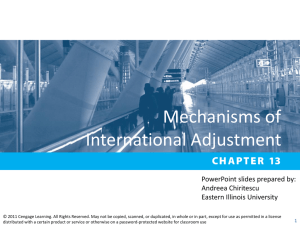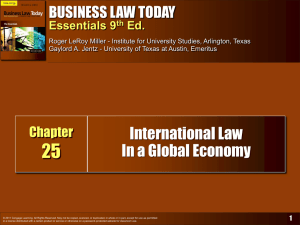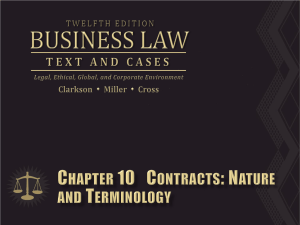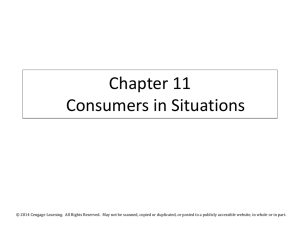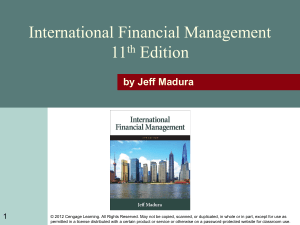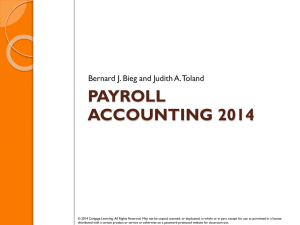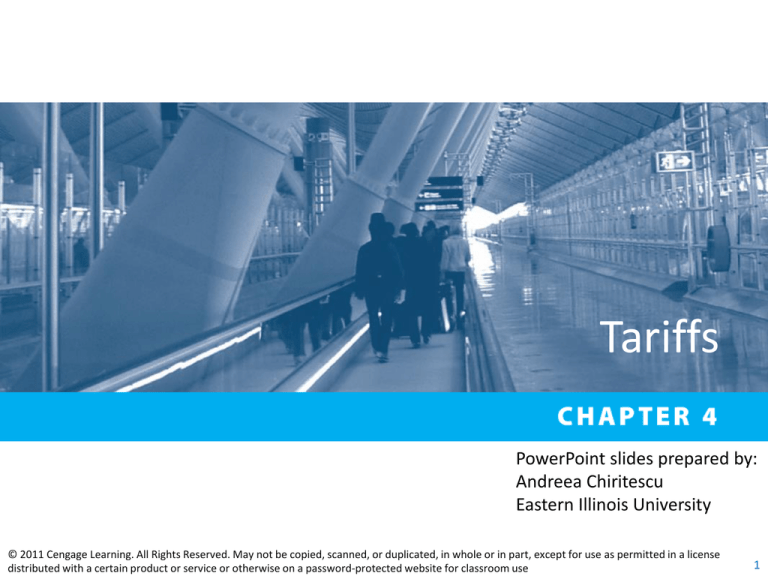
Tariffs
PowerPoint slides prepared by:
Andreea Chiritescu
Eastern Illinois University
© 2011 Cengage Learning. All Rights Reserved. May not be copied, scanned, or duplicated, in whole or in part, except for use as permitted in a license
distributed with a certain product or service or otherwise on a password‐protected website for classroom use
1
The Tariff Concept
• Tariff
• A tax (duty) levied on a product when it crosses
national boundaries
• Import tariff
• Tax levied on an imported product
• Export tariff
• Tax imposed on an exported product
• Often used by developing nations
• Raise revenue, increase the world price
© 2011 Cengage Learning. All Rights Reserved. May not be copied, scanned, or duplicated, in whole or in part, except for use as permitted in a license
distributed with a certain product or service or otherwise on a password‐protected website for classroom use
2
The Tariff Concept
• Protective tariff
• To reduce the amount of imports entering a
country
• Insulating import-competing producers from
foreign competition
• Allows an increase in the output of importcompeting producers
• Revenue tariff
• To generate tax revenues
• Placed on either exports or imports
© 2011 Cengage Learning. All Rights Reserved. May not be copied, scanned, or duplicated, in whole or in part, except for use as permitted in a license
distributed with a certain product or service or otherwise on a password‐protected website for classroom use
3
TABLE 4.1 Tariff revenues as a percentage of government
revenues, 2007: selected countries
Developing Countries
The Bahamas
Guinea
Ethiopia
Ghana
Sierra Leone
Madagascar
Dominican Republic
Jordan
Percentage
51.2
47.9
33.5
28.5
27.6
26.9
20.9
11.3
Industrial Countries
New Zealand
Australia
Japan
Canada
Switzerland
United States
United Kingdom
Iceland
Percentage
2.6
2.5
1.2
1.2
1.2
1.1
1.0
1.0
© 2011 Cengage Learning. All Rights Reserved. May not be copied, scanned, or duplicated, in whole or in part, except for use as permitted in a license
distributed with a certain product or service or otherwise on a password‐protected website for classroom use
4
Types of Tariffs
• Specific tariff
• Fixed amount of money per physical unit of the
imported product
• Relatively easy to apply and administer
• Degree of protection it affords domestic
producers varies inversely with changes in
import prices
• Provides domestic producers more protection
during a business recession
© 2011 Cengage Learning. All Rights Reserved. May not be copied, scanned, or duplicated, in whole or in part, except for use as permitted in a license
distributed with a certain product or service or otherwise on a password‐protected website for classroom use
5
Types of Tariffs
• Ad valorem (of value) tariff
• Fixed percentage of the value of the imported
product
• Distinguish among small differentials in product
quality
• Tends to maintain a constant degree of
protection for domestic producers
© 2011 Cengage Learning. All Rights Reserved. May not be copied, scanned, or duplicated, in whole or in part, except for use as permitted in a license
distributed with a certain product or service or otherwise on a password‐protected website for classroom use
6
Types of Tariffs
• Ad valorem (of value) tariff
• Customs valuation problems
• Estimations by customs appraisers
• FOB vs. CIF valuation
• Free-on-board valuation
• Cost-insurance-freight valuation
• Includes transportation costs
© 2011 Cengage Learning. All Rights Reserved. May not be copied, scanned, or duplicated, in whole or in part, except for use as permitted in a license
distributed with a certain product or service or otherwise on a password‐protected website for classroom use
7
Types of Tariffs
• Compound tariff
• Combination of specific and ad valorem tariffs
• For manufactured products
• Embodying raw materials that are subject to tariffs
• Specific tariff
• Neutralizes the cost disadvantage of domestic
manufacturers - from tariff protection granted to
domestic suppliers of raw materials
• Ad valorem tariff
• Protects the finished-goods industry
© 2011 Cengage Learning. All Rights Reserved. May not be copied, scanned, or duplicated, in whole or in part, except for use as permitted in a license
distributed with a certain product or service or otherwise on a password‐protected website for classroom use
8
TABLE 4.2
Selected U.S. tariffs
© 2011 Cengage Learning. All Rights Reserved. May not be copied, scanned, or duplicated, in whole or in part, except for use as permitted in a license
distributed with a certain product or service or otherwise on a password‐protected website for classroom use
9
TABLE 4.3
Examples of tariffs, selected countries (in %)
© 2011 Cengage Learning. All Rights Reserved. May not be copied, scanned, or duplicated, in whole or in part, except for use as permitted in a license
distributed with a certain product or service or otherwise on a password‐protected website for classroom use
10
Effective Rate of Protection
• Nominal tariff rate
• Published in the country’s tariff schedule
• Applies to the value of a finished product that
is imported into a country
• Effective tariff rate
• Takes into account the nominal tariff rate
• On a finished product
• And any tariff rate applied to imported inputs
• Used in producing the finished product
© 2011 Cengage Learning. All Rights Reserved. May not be copied, scanned, or duplicated, in whole or in part, except for use as permitted in a license
distributed with a certain product or service or otherwise on a password‐protected website for classroom use
11
TABLE 4.4
The effective rate of protection
© 2011 Cengage Learning. All Rights Reserved. May not be copied, scanned, or duplicated, in whole or in part, except for use as permitted in a license
distributed with a certain product or service or otherwise on a password‐protected website for classroom use
12
Effective Rate of Protection
• Effective tariff rate, e
• e = The effective rate of protection
• n = the nominal tariff rate on the final product
• a = the ratio of the value of the imported input to
the value of the finished product
• b = the nominal tariff rate on the imported input
n ab
e
1 a
© 2011 Cengage Learning. All Rights Reserved. May not be copied, scanned, or duplicated, in whole or in part, except for use as permitted in a license
distributed with a certain product or service or otherwise on a password‐protected website for classroom use
13
Effective Rate of Protection
• If the tariff on the finished product
• Exceeds the tariff on the imported input
• Effective rate of protection exceeds the
nominal tariff
© 2011 Cengage Learning. All Rights Reserved. May not be copied, scanned, or duplicated, in whole or in part, except for use as permitted in a license
distributed with a certain product or service or otherwise on a password‐protected website for classroom use
14
Effective Rate of Protection
• If the tariff on the finished product
• Is less than the tariff on the imported input
• Effective rate of protection is less than the
nominal tariff
• May even be negative
• Protects domestic suppliers of raw materials
more than domestic manufacturers
© 2011 Cengage Learning. All Rights Reserved. May not be copied, scanned, or duplicated, in whole or in part, except for use as permitted in a license
distributed with a certain product or service or otherwise on a password‐protected website for classroom use
15
TABLE 4.5
China’s nominal and effective tariff rates in
forestry products, 2001
© 2011 Cengage Learning. All Rights Reserved. May not be copied, scanned, or duplicated, in whole or in part, except for use as permitted in a license
distributed with a certain product or service or otherwise on a password‐protected website for classroom use
16
Tariff Escalation
• Tariff escalation
• Raw materials are often imported at zero or
low tariff rates
• The nominal and effective protection increases
at each stage of production
• Processed goods
• Higher import tariffs
© 2011 Cengage Learning. All Rights Reserved. May not be copied, scanned, or duplicated, in whole or in part, except for use as permitted in a license
distributed with a certain product or service or otherwise on a password‐protected website for classroom use
17
FIGURE 4.1
Tariff escalation on industrial countries’
imports from developing countries
Tariffs often rise significantly with the level of processing (tariff escalation) in many industrial countries. This is
especially true for agricultural products. Tariff escalation in industrial countries has the potential of reducing demand
for processed imports from developing countries, hampering diversification into higher-value added exports.
© 2011 Cengage Learning. All Rights Reserved. May not be copied, scanned, or duplicated, in whole or in part, except for use as permitted in a license
distributed with a certain product or service or otherwise on a password‐protected website for classroom use
18
Outsourcing and Offshore-Assembly
Provision
• Outsourcing
• Certain aspects of a product’s manufacture are
performed in more than one country
• Improvements in cost competitiveness
• Penetrate foreign markets
• High tariffs or other trade barriers restrict the
direct export of finished goods
• Unique foreign production technologies, labor
skills, raw materials, or specialized components
© 2011 Cengage Learning. All Rights Reserved. May not be copied, scanned, or duplicated, in whole or in part, except for use as permitted in a license
distributed with a certain product or service or otherwise on a password‐protected website for classroom use
19
Outsourcing and Offshore-Assembly
Provision
• Offshore-assembly provision (OAP)
• Favorable treatment to products assembled
abroad from U.S.-manufactured components
• Cost of the U.S. component - not included in the
dutiable value of the imported assembled article
• Incentives for foreign manufacturers to
purchase components from U.S. sources
• Generates sales and jobs in the U.S. component
industries
© 2011 Cengage Learning. All Rights Reserved. May not be copied, scanned, or duplicated, in whole or in part, except for use as permitted in a license
distributed with a certain product or service or otherwise on a password‐protected website for classroom use
20
Dodging Import Tariffs: Tariff Avoidance
and Tariff Evasion
• Tariff avoidance
• Legal utilization of the tariff system to one’s
own advantage
• To reduce the amount of tariff that is payable
by means that are within the law
• Tariff evasion
• Individuals or firms evade tariffs by illegal
means
© 2011 Cengage Learning. All Rights Reserved. May not be copied, scanned, or duplicated, in whole or in part, except for use as permitted in a license
distributed with a certain product or service or otherwise on a password‐protected website for classroom use
21
Dodging Import Tariffs: Tariff Avoidance
and Tariff Evasion
• Ford Motor Company
• Ships its Transit Connect five-passenger wagons
• From its factory in Turkey to Baltimore, MD
• Wagons: 2.5% tariff (duty of $625)
• Stripped and converted into cargo vanns
• Cargo vans tariff: 25% (duty of $6,250)
• Completely legal
© 2011 Cengage Learning. All Rights Reserved. May not be copied, scanned, or duplicated, in whole or in part, except for use as permitted in a license
distributed with a certain product or service or otherwise on a password‐protected website for classroom use
22
Dodging Import Tariffs: Tariff Avoidance
and Tariff Evasion
• Smuggled steel evades U.S. tariff
• Falsely reclassify steel as a duty-free product
• Detach markings which indicate that the steel
came from a country subject to tariffs
• Make it appear to have come from one that is
exempt
• Alter the chemical composition of a steel
product enough so that it can be labeled dutyfree
© 2011 Cengage Learning. All Rights Reserved. May not be copied, scanned, or duplicated, in whole or in part, except for use as permitted in a license
distributed with a certain product or service or otherwise on a password‐protected website for classroom use
23
Postponing Import Tariffs
• Bonded warehouse
• Dutiable imports can be brought into the U.S.
and temporarily left in a bonded warehouse,
duty-free
• Imported goods - stored, repacked, or further
processed - for up to five years
• No customs duties are owed until the goods
are withdrawn for domestic consumption
© 2011 Cengage Learning. All Rights Reserved. May not be copied, scanned, or duplicated, in whole or in part, except for use as permitted in a license
distributed with a certain product or service or otherwise on a password‐protected website for classroom use
24
Postponing Import Tariffs
• Foreign-trade zone (FTZ)
• An area within the U.S.
• Business can operate without the responsibility of
paying customs duties on imported products or
materials
• For as long as they remain within this area
• And do not enter the U.S. marketplace
• Customs duties are due when goods are
transferred from the FTZ for U.S. consumption
© 2011 Cengage Learning. All Rights Reserved. May not be copied, scanned, or duplicated, in whole or in part, except for use as permitted in a license
distributed with a certain product or service or otherwise on a password‐protected website for classroom use
25
Postponing Import Tariffs
• Foreign-trade zone (FTZ)
• No time limit on how long goods can be stored
• General-purpose zones
• Public facilities
• Used by more than one firm
• Subzones
• A single firm’s site
• Used for more extensive manufacturing or
assembly
© 2011 Cengage Learning. All Rights Reserved. May not be copied, scanned, or duplicated, in whole or in part, except for use as permitted in a license
distributed with a certain product or service or otherwise on a password‐protected website for classroom use
26
Tariff Effects: An Overview
• Tariff effects
•
•
•
•
Higher price of imports
Lower demand for imports
Domestic suppliers expand output
Benefits
• Domestic producers
© 2011 Cengage Learning. All Rights Reserved. May not be copied, scanned, or duplicated, in whole or in part, except for use as permitted in a license
distributed with a certain product or service or otherwise on a password‐protected website for classroom use
27
Tariff Effects: An Overview
• Tariff - imposes costs to domestic economy
• Buyers will pay more for their protected U.S.-made
goods than they would have for the imported
goods under free trade
• Jobs will be lost at retail and shipping companies
that import foreign-made goods
• Jobs will be lost in any domestic industries that
suffer from retaliatory tariffs
• The extra cost of the goods gets passed on to
whatever products and services that use these
goods in the production process
© 2011 Cengage Learning. All Rights Reserved. May not be copied, scanned, or duplicated, in whole or in part, except for use as permitted in a license
distributed with a certain product or service or otherwise on a password‐protected website for classroom use
28
Tariff Welfare Effects
• Consumer surplus
• The difference between the amount that
buyers would be willing and able to pay for a
good and the actual amount they do pay
• Affected by the market price
• A decrease in the market price
• Increase in the quantity purchased
• Larger consumer surplus
• A higher market price
• Reduce the amount purchased
• Shrink the consumer surplus
© 2011 Cengage Learning. All Rights Reserved. May not be copied, scanned, or duplicated, in whole or in part, except for use as permitted in a license
distributed with a certain product or service or otherwise on a password‐protected website for classroom use
29
Tariff Welfare Effects
• Producer surplus
• Revenue producers receive over and above the
minimum amount required to induce them to
supply a good
• Affected by the market price
• A higher market price
• Increase in quantity supplied
• Higher surplus
• A lower market price
• Lower surplus
© 2011 Cengage Learning. All Rights Reserved. May not be copied, scanned, or duplicated, in whole or in part, except for use as permitted in a license
distributed with a certain product or service or otherwise on a password‐protected website for classroom use
30
FIGURE 4.2
Consumer surplus and producer surplus
Consumer surplus is the difference between the maximum amount buyers are willing to pay for a
given quantity of a good and the amount actually paid. Graphically, consumer surplus is represented
by the area under the demand curve and above the good’s market price. Producer surplus is the
revenue producers receive over and above the minimum necessary for production. Graphically,
producer surplus is the area above the supply curve and below the good’s market price.
© 2011 Cengage Learning. All Rights Reserved. May not be copied, scanned, or duplicated, in whole or in part, except for use as permitted in a license
distributed with a certain product or service or otherwise on a password‐protected website for classroom use
31
Tariff Welfare Effects: Small-Nation Model
• Small nation
• Its imports - a very small portion of the world
market supply
• Price taker
• Tariff effects
• Raises the home price of imports by the full
amount of the duty
• Higher domestic production
• Lower domestic consumption
© 2011 Cengage Learning. All Rights Reserved. May not be copied, scanned, or duplicated, in whole or in part, except for use as permitted in a license
distributed with a certain product or service or otherwise on a password‐protected website for classroom use
32
Tariff Welfare Effects: Small-Nation Model
• Small nation - Tariff effects on nation’s welfare
• Consumer surplus falls
• Welfare effects of a tariff
•
•
•
•
•
•
•
•
Revenue effect
Redistribution effect
Protective effect
Consumption effect
Additional tax revenue
Benefits domestic producers
Wastes resources
Harms the domestic consumer
© 2011 Cengage Learning. All Rights Reserved. May not be copied, scanned, or duplicated, in whole or in part, except for use as permitted in a license
distributed with a certain product or service or otherwise on a password‐protected website for classroom use
33
FIGURE 4.3 Tariff trade and welfare effects: small nation model
For a small nation, a tariff placed on an imported product is shifted totally to the domestic
consumer via a higher product price. Consumer surplus falls as a result of the price increase. The
small nation’s welfare decreases by an amount equal to the protective effect and consumption
effect, the so-called deadweight losses due to a tariff.
© 2011 Cengage Learning. All Rights Reserved. May not be copied, scanned, or duplicated, in whole or in part, except for use as permitted in a license
distributed with a certain product or service or otherwise on a password‐protected website for classroom use
34
Tariff Welfare Effects: Small-Nation Model
• Revenue effect
• The government’s collections of duty
• Number of imports times the tariff
• Portion of the loss in consumer surplus
• Transferred to the government
• Does not result in an overall welfare loss
© 2011 Cengage Learning. All Rights Reserved. May not be copied, scanned, or duplicated, in whole or in part, except for use as permitted in a license
distributed with a certain product or service or otherwise on a password‐protected website for classroom use
35
Tariff Welfare Effects: Small-Nation Model
• Redistribution effect
• Transfer of the consumer surplus
• To the domestic producers of the importcompeting product
• Transfer of income from consumers to
producers
• Does not result in an overall loss of welfare for
the economy
© 2011 Cengage Learning. All Rights Reserved. May not be copied, scanned, or duplicated, in whole or in part, except for use as permitted in a license
distributed with a certain product or service or otherwise on a password‐protected website for classroom use
36
Tariff Welfare Effects: Small-Nation Model
• Protective effect
• Loss to the domestic economy
• From wasted resources used to produce additional
goods at increasing unit costs
• Less efficient domestic production is
substituted for more efficient foreign
production
• Loss of welfare
© 2011 Cengage Learning. All Rights Reserved. May not be copied, scanned, or duplicated, in whole or in part, except for use as permitted in a license
distributed with a certain product or service or otherwise on a password‐protected website for classroom use
37
Tariff Welfare Effects: Small-Nation Model
• Consumption effect
• Residual not accounted for elsewhere
• Loss of welfare occurs
• Increased price
• Lower consumption
• Deadweight loss of the tariff
• Protective effect
• Consumption effect
© 2011 Cengage Learning. All Rights Reserved. May not be copied, scanned, or duplicated, in whole or in part, except for use as permitted in a license
distributed with a certain product or service or otherwise on a password‐protected website for classroom use
38
GLOBALIZATION
Trade protectionism intensifies as
global economy falls into recession
• Global economic downturns - catalyst for trade
protectionism; 2007–2009,
• Decrease in the demand for goods and services
• Decline in international trade
• Credit crunch - extra squeeze on trade
• Shortfall of some $100 billion in trade finance –
90% of world trade
© 2011 Cengage Learning. All Rights Reserved. May not be copied, scanned, or duplicated, in whole or in part, except for use as permitted in a license
distributed with a certain product or service or otherwise on a password‐protected website for classroom use
39
GLOBALIZATION
Trade protectionism intensifies as
global economy falls into recession
• Indiscriminate decrease in trade
• Exports declined by 30 %
• China - targeted by the most governments for
protectionist measures
• Russia
• Increased tariffs on imported automobiles
• India
• Raised tariffs on steel imports
• Argentina
• New obstacles to imported auto parts and shoes
© 2011 Cengage Learning. All Rights Reserved. May not be copied, scanned, or duplicated, in whole or in part, except for use as permitted in a license
distributed with a certain product or service or otherwise on a password‐protected website for classroom use
40
TABLE 4.6
Creeping protectionism during global economic downturn of
2008–2009: number of protectionist measures initiated*
© 2011 Cengage Learning. All Rights Reserved. May not be copied, scanned, or duplicated, in whole or in part, except for use as permitted in a license
distributed with a certain product or service or otherwise on a password‐protected website for classroom use
41
GLOBALIZATION
Trade protectionism intensifies as
global economy falls into recession
• United States, steel industry
• Increased tariffs
• $100 billion U.S. steel market
• Not protected by the “Buy American ” legislation
• Fiscal stimulus program
• Shut out foreign companies from U.S. government
contracts (25% of new steel orders in 2009)
© 2011 Cengage Learning. All Rights Reserved. May not be copied, scanned, or duplicated, in whole or in part, except for use as permitted in a license
distributed with a certain product or service or otherwise on a password‐protected website for classroom use
42
GLOBALIZATION
Trade protectionism intensifies as
global economy falls into recession
• United States, tires
• Tariffs of 25-35% on imports from China
• For the next three years
• Priced out of the market 17% of all tires sold in the
United States
• Forced up the market price for consumers
© 2011 Cengage Learning. All Rights Reserved. May not be copied, scanned, or duplicated, in whole or in part, except for use as permitted in a license
distributed with a certain product or service or otherwise on a password‐protected website for classroom use
43
GLOBALIZATION
Trade protectionism intensifies as
global economy falls into recession
• Once trade barriers are increased
• Can severely damage global supply chains
• It can take years of negotiation to dismantle
trade barriers
• It can take years before global supply chains
can be restored
© 2011 Cengage Learning. All Rights Reserved. May not be copied, scanned, or duplicated, in whole or in part, except for use as permitted in a license
distributed with a certain product or service or otherwise on a password‐protected website for classroom use
44
Tariff Welfare Effects: Large-Nation Model
• Large-nation
• An importing nation large enough
• Changes in the quantity of its imports
• By means of tariff policy
• Influence the world price of the product
• United States
• Autos, steel, oil, and consumer electronics
• Japan
• European Union
© 2011 Cengage Learning. All Rights Reserved. May not be copied, scanned, or duplicated, in whole or in part, except for use as permitted in a license
distributed with a certain product or service or otherwise on a password‐protected website for classroom use
45
Tariff Welfare Effects: Large-Nation Model
• United States - tariff on automobile imports
• Prices increase for American consumers
• Decrease in the quantity demanded
• If significant enough - force Japanese firms to
reduce the prices of their exports
© 2011 Cengage Learning. All Rights Reserved. May not be copied, scanned, or duplicated, in whole or in part, except for use as permitted in a license
distributed with a certain product or service or otherwise on a password‐protected website for classroom use
46
TABLE 4.7 Effects of increases in U.S. tariffs on the world price
of imported goods
© 2011 Cengage Learning. All Rights Reserved. May not be copied, scanned, or duplicated, in whole or in part, except for use as permitted in a license
distributed with a certain product or service or otherwise on a password‐protected website for classroom use
47
Tariff Welfare Effects: Large-Nation Model
• Economic effects of an import tariff
• Redistributive effect
• From domestic consumers to domestic producers
• Deadweight loss
• Consumption effect
• Protective effect
• Revenue effect
• Domestic revenue effect
• Terms-of-trade effect
© 2011 Cengage Learning. All Rights Reserved. May not be copied, scanned, or duplicated, in whole or in part, except for use as permitted in a license
distributed with a certain product or service or otherwise on a password‐protected website for classroom use
48
FIGURE 4.4
Tariff trade and welfare effects: large nation model
For a large nation, a tariff on an imported product may be partially shifted to the domestic consumer via a
higher product price and partially absorbed by the foreign exporter via a lower export price. The extent by
which a tariff is absorbed by the foreign exporter constitutes a welfare gain for the home country. This gain
offsets some (all) of the deadweight welfare losses due to the tariff’s consumption and protective effects.
© 2011 Cengage Learning. All Rights Reserved. May not be copied, scanned, or duplicated, in whole or in part, except for use as permitted in a license
distributed with a certain product or service or otherwise on a password‐protected website for classroom use
49
Tariff Welfare Effects: Large-Nation Model
• In figure 4.4
• If e > (b + d)
• National welfare is increased
• If e = (b + d)
• National welfare remains constant
• If e > (b + d)
• National welfare is diminished
© 2011 Cengage Learning. All Rights Reserved. May not be copied, scanned, or duplicated, in whole or in part, except for use as permitted in a license
distributed with a certain product or service or otherwise on a password‐protected website for classroom use
50
Tariff Welfare Effects: Large-Nation Model
• Optimum tariff
• Maximize the positive difference between
• Gain of improving terms of trade (area e)
• Loss in economic efficiency from the protective
effect (area b)
• Consumption effect (area d)
• Is only beneficial to the importing nation
• Beggar-thy-neighbor policy, could invite
retaliation
© 2011 Cengage Learning. All Rights Reserved. May not be copied, scanned, or duplicated, in whole or in part, except for use as permitted in a license
distributed with a certain product or service or otherwise on a password‐protected website for classroom use
51
TRADE
CONFLICTS
Gains from eliminating import tariffs
• If only United States removed tariffs and other
restraints on imported products
•
•
•
•
•
Lowers the price of the affected imports
Lower the price of the competing U.S. good
Economic gains to the U.S. consumer
Decrease the production costs
Domestic profit reductions
© 2011 Cengage Learning. All Rights Reserved. May not be copied, scanned, or duplicated, in whole or in part, except for use as permitted in a license
distributed with a certain product or service or otherwise on a password‐protected website for classroom use
52
TRADE
CONFLICTS
Gains from eliminating import tariffs
• If only United States removed tariffs and other
restraints on imported products
• Displaced workers from the domestic industry
that loses protection
• U.S. government loses tax revenue
• Estimated annual economic welfare gains from
eliminating significant import restraints
• Welfare gain of about $3.7 billion to the U.S.
economy
© 2011 Cengage Learning. All Rights Reserved. May not be copied, scanned, or duplicated, in whole or in part, except for use as permitted in a license
distributed with a certain product or service or otherwise on a password‐protected website for classroom use
53
TABLE 4.8 Economic welfare gains from liberalization of
significant import restraints*, 2005 (millions of dollars)
Annual change in Economic Welfare
Import-Competing Industry
Textiles and apparel
Sugar
Dairy
Footwear
Ethyl alcohol
Beef
Tuna
Glass products
Tobacco
$1,885 millions
811
573
249
120
48
24
20
19
*Import tariffs, tariff-rate quotas, and import quotas
© 2011 Cengage Learning. All Rights Reserved. May not be copied, scanned, or duplicated, in whole or in part, except for use as permitted in a license
distributed with a certain product or service or otherwise on a password‐protected website for classroom use
54
How a Tariff Burdens Exporters
• Effects of import tariffs on exporters
• Higher production costs – from imported inputs
• Cannot pass it to the buyers
• Higher prices
• Reduced overseas sales
• Raise the cost of living
• Higher wages
• Higher production costs
• International repercussions
• Lead to reductions in domestic exports
© 2011 Cengage Learning. All Rights Reserved. May not be copied, scanned, or duplicated, in whole or in part, except for use as permitted in a license
distributed with a certain product or service or otherwise on a password‐protected website for classroom use
55
FIGURE 4.5 How an import tariff burdens domestic exporters
A tariff placed on imported steel increases the costs of a steel-using manufacturer. This
increase leads to a higher price charged by the manufacturer and a loss of international
competitiveness.
© 2011 Cengage Learning. All Rights Reserved. May not be copied, scanned, or duplicated, in whole or in part, except for use as permitted in a license
distributed with a certain product or service or otherwise on a password‐protected website for classroom use
56
Steel Tariffs Buy Time for Troubled Industry
• 2001, President Bush, import tariff program
• Revitalize steel industry
• American steel companies - lack of
competitiveness
• Heavy burden on American steel-using
industries
• Temporarily save roughly 6,000 jobs
• At a cost to U.S. consumers and steel-using firms:
$800,000 -$1.1 million per job
© 2011 Cengage Learning. All Rights Reserved. May not be copied, scanned, or duplicated, in whole or in part, except for use as permitted in a license
distributed with a certain product or service or otherwise on a password‐protected website for classroom use
57
Steel Tariffs Buy Time for Troubled Industry
• 2001, President Bush, import tariff program
• Save 1 job in steel manufacturing – at a cost of
13 jobs in steel-using industries
• Increased production costs for a large number
of U.S. companies that use steel
• 2007, Government trade regulators
• Revoke tariffs on high-end steel imports from
certain countries
© 2011 Cengage Learning. All Rights Reserved. May not be copied, scanned, or duplicated, in whole or in part, except for use as permitted in a license
distributed with a certain product or service or otherwise on a password‐protected website for classroom use
58
TABLE 4.9 President Bush’s steel trade remedy program of
2002–2003: selected products
© 2011 Cengage Learning. All Rights Reserved. May not be copied, scanned, or duplicated, in whole or in part, except for use as permitted in a license
distributed with a certain product or service or otherwise on a password‐protected website for classroom use
59
Tariffs and the Poor
• Tariffs are inequitable
• Impose the most severe costs on low-income
families
• Higher tariffs on cheap goods than luxuries
• Affect different countries in different ways
• Burdens countries that specialize in the cheapest
goods
• Very poor countries in Asia and the Middle East
© 2011 Cengage Learning. All Rights Reserved. May not be copied, scanned, or duplicated, in whole or in part, except for use as permitted in a license
distributed with a certain product or service or otherwise on a password‐protected website for classroom use
60
TABLE 4.10 U.S. tariffs are high on cheap goods, low on luxuries
© 2011 Cengage Learning. All Rights Reserved. May not be copied, scanned, or duplicated, in whole or in part, except for use as permitted in a license
distributed with a certain product or service or otherwise on a password‐protected website for classroom use
61
Arguments for Trade Restrictions
• Free-trade argument
• If each nation produces what it does best and
permits trade
• In the long term
• Lower prices
• Higher levels of output, income, and consumption
© 2011 Cengage Learning. All Rights Reserved. May not be copied, scanned, or duplicated, in whole or in part, except for use as permitted in a license
distributed with a certain product or service or otherwise on a password‐protected website for classroom use
62
Arguments for Trade Restrictions
• Job protection argument
• Alleged job losses to foreign competition
• Omits: dual nature of international trade
• Trade restrictions on textiles and apparel, steel,
and automobiles
• Little or no positive effect on the level of
employment in the long run
© 2011 Cengage Learning. All Rights Reserved. May not be copied, scanned, or duplicated, in whole or in part, except for use as permitted in a license
distributed with a certain product or service or otherwise on a password‐protected website for classroom use
63
Arguments for Trade Restrictions
• Job protection argument
• Job gains for only a few industries
• Job losses spread across many industries
• Each job saved
• Ends up costing domestic consumers more than the
worker’s salary
© 2011 Cengage Learning. All Rights Reserved. May not be copied, scanned, or duplicated, in whole or in part, except for use as permitted in a license
distributed with a certain product or service or otherwise on a password‐protected website for classroom use
64
Arguments for Trade Restrictions
• Protection against cheap foreign labor
• Low wages abroad make it difficult for U.S.
producers to compete with producers using
cheap foreign labor
• Fails to recognize the links among efficiency,
wages, and production costs
• Low wages by themselves do not guarantee
low production costs
• Low-wage nations -competitive advantage
• Only in the production of goods requiring greater
labor and little of the other factor inputs
© 2011 Cengage Learning. All Rights Reserved. May not be copied, scanned, or duplicated, in whole or in part, except for use as permitted in a license
distributed with a certain product or service or otherwise on a password‐protected website for classroom use
65
TABLE 4.11 Hourly compensation costs in U.S. dollars for
production workers in manufacturing, 2007
© 2011 Cengage Learning. All Rights Reserved. May not be copied, scanned, or duplicated, in whole or in part, except for use as permitted in a license
distributed with a certain product or service or otherwise on a password‐protected website for classroom use
66
TABLE 4.12 Productivity, wages, and unit labor costs, relative to
the U.S.: total manufacturing, 2002 (U.S.= 1.0)
© 2011 Cengage Learning. All Rights Reserved. May not be copied, scanned, or duplicated, in whole or in part, except for use as permitted in a license
distributed with a certain product or service or otherwise on a password‐protected website for classroom use
67
Arguments for Trade Restrictions
• Fairness in trade
• Foreign governments play by a different set of
rules
• Foreign firms unfair competitive advantages
• Trade benefits the domestic economy even if
foreign nations impose trade restrictions
• Does not recognize the potential impact on
global trade
© 2011 Cengage Learning. All Rights Reserved. May not be copied, scanned, or duplicated, in whole or in part, except for use as permitted in a license
distributed with a certain product or service or otherwise on a password‐protected website for classroom use
68
Arguments for Trade Restrictions
• Maintenance of the domestic standard of living
• One nation imposes a tariff that improves its
income and employment
• At the expense of its trading partner’s living
standard
• Retaliatory tariffs
• Lower level of welfare for all nations
© 2011 Cengage Learning. All Rights Reserved. May not be copied, scanned, or duplicated, in whole or in part, except for use as permitted in a license
distributed with a certain product or service or otherwise on a password‐protected website for classroom use
69
Arguments for Trade Restrictions
• Equalization of production costs
• Scientific tariff - to eliminate unfair competition
from abroad
• Problems
• Different costs across business
• Higher domestic prices
• Benefit efficient domestic companies
• Domestic consumer would be subsidizing inefficient
production
© 2011 Cengage Learning. All Rights Reserved. May not be copied, scanned, or duplicated, in whole or in part, except for use as permitted in a license
distributed with a certain product or service or otherwise on a password‐protected website for classroom use
70
Arguments for Trade Restrictions
• Equalization of production costs
• Approximates a prohibitive tariff
• Completely contradicts the notion of comparative
advantage
• Wipes out the basis for trade and gains from trade
© 2011 Cengage Learning. All Rights Reserved. May not be copied, scanned, or duplicated, in whole or in part, except for use as permitted in a license
distributed with a certain product or service or otherwise on a password‐protected website for classroom use
71
Arguments for Trade Restrictions
• Infant-industry argument
• Trading nations should temporarily shield their
newly developing industries from foreign
competition
• Once a protective tariff is imposed - very
difficult to remove
• Special-interest groups - convince policy makers
that further protection is justified
© 2011 Cengage Learning. All Rights Reserved. May not be copied, scanned, or duplicated, in whole or in part, except for use as permitted in a license
distributed with a certain product or service or otherwise on a password‐protected website for classroom use
72
Arguments for Trade Restrictions
• Infant-industry argument
• Very difficult to determine which industries will
be capable of realizing comparative advantage
potential
• Not valid for mature, industrialized nations
• There may be other ways of insulating a
developing industry from cutthroat
competition
• Subsidize the industry
© 2011 Cengage Learning. All Rights Reserved. May not be copied, scanned, or duplicated, in whole or in part, except for use as permitted in a license
distributed with a certain product or service or otherwise on a password‐protected website for classroom use
73
Arguments for Trade Restrictions
• Noneconomic arguments
• National security argument
• Protect essential industries
• What constitutes an essential industry
• Cultural and sociological considerations
• Arguments justifying tariffs
• Based on the assumption that the national
welfare, as well as the individual’s welfare, will
be enhanced
© 2011 Cengage Learning. All Rights Reserved. May not be copied, scanned, or duplicated, in whole or in part, except for use as permitted in a license
distributed with a certain product or service or otherwise on a password‐protected website for classroom use
74
TRADE
CONFLICTS
Petition of the candle makers
• Frederic Bastiat, French Chamber of Deputies
• Satire of protectionists’ arguments, 1845
• A law be passed requiring people to shut all
windows, doors, and so forth
• So that the candle industry would be protected
from the “unfair” competition of the sun
• Great benefit to the candle industry
• Creating many new jobs and enriching suppliers
© 2011 Cengage Learning. All Rights Reserved. May not be copied, scanned, or duplicated, in whole or in part, except for use as permitted in a license
distributed with a certain product or service or otherwise on a password‐protected website for classroom use
75
Arguments for Trade Restrictions
• Political economy of protectionism
• Elected officials form policies to maximize votes
and remain in office
• Bias in the political system that favors
protectionism
• Protection-biased sector
• Import competing producers
• Labor unions - in that industry
• Suppliers to the producers in the industry
© 2011 Cengage Learning. All Rights Reserved. May not be copied, scanned, or duplicated, in whole or in part, except for use as permitted in a license
distributed with a certain product or service or otherwise on a password‐protected website for classroom use
76
Arguments for Trade Restrictions
• Political economy of protectionism
• Protection-biased sector
• Seekers of protectionism
• Established firms in an aging industry - lost their
comparative advantage
• Free-trade-biased sector
• Exporting producers, their workers, and their
suppliers
© 2011 Cengage Learning. All Rights Reserved. May not be copied, scanned, or duplicated, in whole or in part, except for use as permitted in a license
distributed with a certain product or service or otherwise on a password‐protected website for classroom use
77
Arguments for Trade Restrictions
• United States’ protection policy
• Dominated by special-interest groups that
represent producers
• Gains from protection – concentrated among wellorganized producers and labor unions
• Consumers
• Not organized; Losses widely dispersed
• Absorb individually a small & difficult-to-identify
cost;
• Uninformed
© 2011 Cengage Learning. All Rights Reserved. May not be copied, scanned, or duplicated, in whole or in part, except for use as permitted in a license
distributed with a certain product or service or otherwise on a password‐protected website for classroom use
78
Arguments for Trade Restrictions
• Supply of protectionism
• By the domestic government
• Depends on:
• The costs to society
• The political importance of import-competing
producers
• Adjustment costs
• Public sympathy
© 2011 Cengage Learning. All Rights Reserved. May not be copied, scanned, or duplicated, in whole or in part, except for use as permitted in a license
distributed with a certain product or service or otherwise on a password‐protected website for classroom use
79
Arguments for Trade Restrictions
• Demand of protectionism
• By the domestic companies and workers
• Depends on:
• Comparative disadvantage
• Import penetration
• Concentration
• Export dependence
© 2011 Cengage Learning. All Rights Reserved. May not be copied, scanned, or duplicated, in whole or in part, except for use as permitted in a license
distributed with a certain product or service or otherwise on a password‐protected website for classroom use
80


